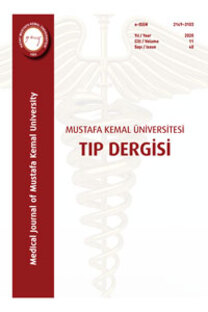Yoğun Bakıma Yatırılan Zehirlenme Olgularının Değerlendirilmesi
Acil Servis, Zehirlenme, Klinik Farmakoloji, Yoğun Bakım Ünitesi, Özkıyım
Evaluation of Poisoning Cases Hospitalized to Intensive Care Unit
Emergency department, poisoning, clinical pharmacology, intensive care unit, suicide,
___
- Tüfek D, Taşdemir BB, Sıvacı R. Retrospective Analysis Of Intoxication Cases Followed Up In Intensive Care Unit. Journal of the Turkish Society of Intensive Care Aug (2017); 15(2): 67-71.
- Vallersnes Om, Jacobsen D, Ekeberg Ø, Brekke M. Patients presenting with acute poisoning to an outpatient emergency clinic: a one-year observational study in Oslo, Norway. BMC Emergency Medicine (2015);15;18.
- Selçuk M, Çakar N. Single-center analysis of acute intoxication:Six-year data case. Türk Yoğun Bakım Derneği Dergisi (2015):13;57-61.
- Yeşil O, Akoğlu H, Onur Ö, Güneysel Ö. Retrospective evaluation of poisoning patients in the emergency department. Marmara Medical Journal 2008;21(1):26-32.
- Köse I, Zincircioğlu Ç, Şenoğlu N, Yılmaz Ç, Atçeken G, Erbay RH. One-year retrospective analysis of poisoning cases admitted to our intensive care unit and evaluation of mortality related factors. Tepecik Eğit. Ve Araşt. Hast. Dergisi 2015; 25(1):28-32.
- Sorge M, Weidhase L, Bernhard M, Gries A, Petros S. Self-poisoning in the acute care medicine 2005-2012. Anaesthesist. 2015 Jun;64(6):456-62.
- Kaya S, Kararmaz A, Karaman H, Turhanoğlu S. The Retrospective analysis of poisoinig cases in intensive care unit. Dicle Tıp Dergisi 2006; 33:242-244.
- Dağlı R, Kocaoğlu N, Bayır H, Hakkı M, Erbesler ZA, Kahraman M, et al. Yoğun bakım servisimizdeki intoksikasyon vakalarının incelenmesi. Muğla Sıtkı Koçman Üniversitesi Tıp dergisi 2016;3(1):17-20.
- 2016 Annual Report of the American Association of Poison Control Centers' National Poison Data System (NPDS): 34th Annual Report. Epub 2017 Nov 29.
- Akkas M. Coşkun F, Ulu N, Sivri B. An epidemilogical evaluation of 1098 acute poisoning cases from Turkey. Vet Hum Toxicol 2004; 46:213-215.
- Özayar E, Değerli S, Güleç H, Şahin S, Dereli N. Retrospective analysis of intoxication cases in the ICU. Dahili ve Cerrahi Bilimler Yoğun Bakım Dergisi 2011;2(3):59-62.
- Forsberg S, Höjer J, Ludwigs U. Hospital mortality among poisoned patients presenting unconscious. ClinToxicol (Phila) 2012; 50:254-257.
- Eddleston M, Juszczak E, Buckley NA, Senarathna L, Mohamed F, Dissanayake W et al. Multiple-dose activated charcoal in acuteself-poisoning: a randomised controlled trial. Lancet 2008; 371:579-587
- ISSN: 2149-3103
- Yayın Aralığı: Yılda 3 Sayı
- Başlangıç: 2010
- Yayıncı: Hatay Mustafa Kemal Üniversitesi Tıp Fakültesi Dekanlığı
Erişkin Başlangıçlı Langerhans Hücreli Histiyositoz
Zeynep BAYRAMOĞLU, Muhammet Zeki GÜLTEKİN, Yaşar ÜNLÜ
Akut Gastrik Dilatasyonda Erken Müdahale Hayat Kurtarır
Sena BALTA, Başak ÖZAY, Mehmet Ali YAVUZ, Kemal Can BALIKÇI, Bülent AKÇORA
Birinci Basamağa Başvuran Bireylerde Hipertansiyon Risk Faktörleri
Nuran ŞAHİN, Pınar DÖNER GÜNER, Emre DİRİCAN, Erhan YENGİL, Cahit ÖZER
Balneoterapinin fibromiyalji hastalarında ağrı ve yaşam kalitesine etkisi
Ahmet KARADAĞ, Mesut PARLAK, Muhammet CANBAŞ
Okan TÜRK, Can YALDIZ, Davut CEYLAN
Obezite ve Ghrelin/Leptin İlişkisi
Aliye Sağkan Öztürk, Abdullah ARPACI
Yoğun Bakıma Yatırılan Zehirlenme Olgularının Değerlendirilmesi
Feride Sinem AKGÜN, Özgür ŞENTÜRK, Zeynep Güneş ÖZÜNAL, Esra SAĞLAM
